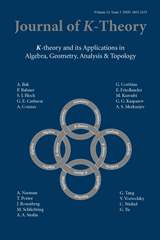Crossref Citations
This article has been cited by the following publications. This list is generated based on data provided by Crossref.
Abrams, Gene
2015.
Leavitt path algebras: the first decade.
Bulletin of Mathematical Sciences,
Vol. 5,
Issue. 1,
p.
59.
Abrams, Gene
Ara, Pere
and
Siles Molina, Mercedes
2017.
Leavitt Path Algebras.
Vol. 2191,
Issue. ,
p.
1.
Abrams, Gene
Ara, Pere
and
Siles Molina, Mercedes
2017.
Leavitt Path Algebras.
Vol. 2191,
Issue. ,
p.
259.
Ara, Pere
Hazrat, Roozbeh
Li, Huanhuan
and
Sims, Aidan
2018.
Graded Steinberg algebras and their representations.
Algebra & Number Theory,
Vol. 12,
Issue. 1,
p.
131.
Hazrat, Roozbeh
and
Li, Huanhuan
2020.
The talented monoid of a Leavitt path algebra.
Journal of Algebra,
Vol. 547,
Issue. ,
p.
430.
Rangaswamy, Kulumani M.
2021.
On graded primitive Leavitt path algebras.
Journal of Algebra and Its Applications,
Vol. 20,
Issue. 09,
p.
2150173.
Ara, Pere
Hazrat, Roozbeh
and
Li, Huanhuan
2022.
Graded K-theory, filtered K-theory and the
classification of graph algebras.
Annals of K-Theory,
Vol. 7,
Issue. 4,
p.
731.
Vaš, Lia
2023.
The Functor $K_{0}^{\operatorname {gr}}$ is Full and only Weakly Faithful.
Algebras and Representation Theory,
Vol. 26,
Issue. 6,
p.
2877.
Bock, Wolfgang
and
Sebandal, Alfilgen N.
2023.
An adjacency matrix perspective of talented monoids and Leavitt path algebras.
Linear Algebra and its Applications,
Vol. 678,
Issue. ,
p.
295.
Arnone, Guido
2023.
Lifting morphisms between graded Grothendieck groups of Leavitt path algebras.
Journal of Algebra,
Vol. 631,
Issue. ,
p.
804.
Gonçalves, Daniel
and
Royer, Danilo
2023.
Properties of the gradings on ultragraph algebras via the underlying combinatorics.
Journal of Algebraic Combinatorics,
Vol. 58,
Issue. 2,
p.
435.
Bock, Wolfgang
Sebandal, Alfilgen
and
Vilela, Jocelyn
2023.
A talented monoid view on Lie bracket algebras over Leavitt path algebras.
Journal of Algebra and Its Applications,
Vol. 22,
Issue. 08,
Arnone, Guido
and
Cortiñas, Guillermo
2023.
Non-existence of graded unital homomorphisms between Leavitt algebras and their Cuntz splices.
Journal of Algebra and Its Applications,
Vol. 22,
Issue. 04,
Cortiñas, Guillermo
and
Hazrat, Roozbeh
2024.
Classification conjectures for Leavitt path algebras.
Bulletin of the London Mathematical Society,
Vol. 56,
Issue. 10,
p.
3011.
Abrams, Gene
Ruiz, Efren
and
Tomforde, Mark
2024.
Recasting the Hazrat Conjecture: Relating Shift Equivalence to Graded Morita Equivalence.
Algebras and Representation Theory,
Vol. 27,
Issue. 2,
p.
1477.
Carlsen, Toke Meier
Dor-On, Adam
and
Eilers, Søren
2024.
Shift equivalences through the lens of
Cuntz–Krieger algebras.
Analysis & PDE,
Vol. 17,
Issue. 1,
p.
345.
Bock, Wolfgang
Hazrat, Roozbeh
and
Sebandal, Alfilgen
2025.
The graded classification conjectures hold for various finite representations of Leavitt path algebras.
Journal of Algebra,
Vol. 672,
Issue. ,
p.
303.


